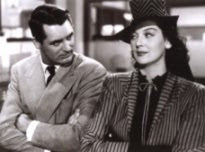
Meryl Streep as Julia Child in Nora Ephron's beloved "Julie & Julia": Is this PBS or "I Love Lucy"?
There's this scene in "Julie & Julia."
"Isn't she adorable?," the immobilized Julie Powell (Amy Adams) asks her husband (Chris Messina) while watching an antique black-&-white PBS episode of Julia Child (Meryl Streep) cooking on-air and goofing off.
Huh? There are a lot of words to describe Julia Child, but "adorable" - writer-director Nora Ephron's word of choice - isn't the one that comes immediately to mind. "Strange" would fit. "Curious" is another politcally-correct way to put it. Ephron has been on talk shows of late to hype her movie and to advance the propaganda that Julia Child "changed things" (largely through her inordinant use of butter). But the fact is, she became a cooking pehnomenom not because she was a great cook but because she was
good television. She was a "character" in every sense of the word. Strange. Curious. Graham Kerr was another cooking oddity of the era (circa the 1970s). He was also good television, and I'm confident that there were a lot of much better chefs who resented all the fawning attention that these two "characters" commanded and received. (Susan Boyle, who actually kind of resembles Child, is the latest example of this craze, only she makes beautiful music, instead of beautiful food.)
But no one fawns like Ephron, a self-proclaimed foodie if not a very good film writer or director. (She is, however, a great writer of short stories.) Her film, which has been receiving knee-jerk love letters from critics, is facile, slapdash and terribly repetitive. Once the conceit is introduced - a dual-biopic of Child and Powell, the young woman inspired and shaped by Child, and the ever-so-slight parallel of their lives - it is repeated over and over again
ad nauseum. The first 20 minutes or so of "Julia & Julia" are brisk and breezy, but then tedium sets in and it becomes tiresome.
To call it episodic would be high praise. Ephron's pacing of her material makes it feel like a season's worth of memorable moments from a popular sitcom that have been edited down and strung together. This is most glaring in the extended sequence that recounts Julia Child dealing with sexism at Le Cordon Bleu and promptly showing up all the men there. It's like something out of an old "I Love Lucy" episode. (Remember the one set on the chocolate-candy assembly line? That's it.)
Serious bits are infrequently tossed in as if Ephron were seasoning a stew with extra salt. We learn that Paul Child (Stanley Tucci), Julia's husband, was brought up before Senator Joe McCarthy on unAmerican activities, but all the panel asks him is if he's a homosexual. Then, it's dropped. Later, when she learns that her sister Dorothy (the invaluable Jane Lynch) is pregnant, the heretofore doltish Julia breaks down in Paul's arms sobbing, implying that she could never have children of her own.
But wait!
The film makes it clear that Julia Child was a virgin until she was 40 and married late in life. And the movie also makes a big deal about Julia and Paul's active sex life (supposedly, intercourse every day after lunch - yeah,
right), but what we see on screen makes us wonder if their relationship was really just a marriage of convenience. Hmmm...
Julie, meanwhile, works - unhappily - for a bureaucratic goverment office set up after 9/11 to deal with inquiries and complaints. She's too good for this job, see, even though she's the only empathetic one in her office. Again, more padding. For good measure, Ephron tosses in a couple gratuitous jokes against the Republicans and they are so low that they even bothered me, and I'm a diehard liberal Democrat.


As for the performances, Streep has, predictably, received most of the acclaim - nay, make that
all of it - but Adams is actually better, simply by virtue of the fact that she (1) struggles with lesser material and (2) is playing a genuine human being.
Streep resorts to a shameless impersonation. The ham in this film isn't on the table. It's a naked parody, but it's not completely Streep's fault: Julia Child was a caricature who doesn't inspired much, if any, subtlety.
Still, Ephron does her star a hugh disservice by including Dan Aykroyd's own impersonation of Child from one of his old "Saturday Night Live" sketches (above), which is every bit as good as what Streep is doing.
He might even be somewhat ...
better. Blasphemy!
"Julie & Julia" is a companionable film, easy to watch, but it's also a missed opportunity, its supporters too love-struck to notice.


 Some of Miyazaki's past films have been released here in both their original Japanese versions and their American-language adaptations. So far, only the John Lassiter-supervised version of "Ponyo" is available here, although it's difficult to quibble when the vocal talent is so extraordinary. Noah Lindsay Cyrus and Frankie Jonas enrich Miyazaki's visuals with their astute line readings as Ponyo and Sōsuke, respectively, but it's Tina Fey who anchors the film with her expressive turn as Sōsuke's working mom.
Some of Miyazaki's past films have been released here in both their original Japanese versions and their American-language adaptations. So far, only the John Lassiter-supervised version of "Ponyo" is available here, although it's difficult to quibble when the vocal talent is so extraordinary. Noah Lindsay Cyrus and Frankie Jonas enrich Miyazaki's visuals with their astute line readings as Ponyo and Sōsuke, respectively, but it's Tina Fey who anchors the film with her expressive turn as Sōsuke's working mom.









































